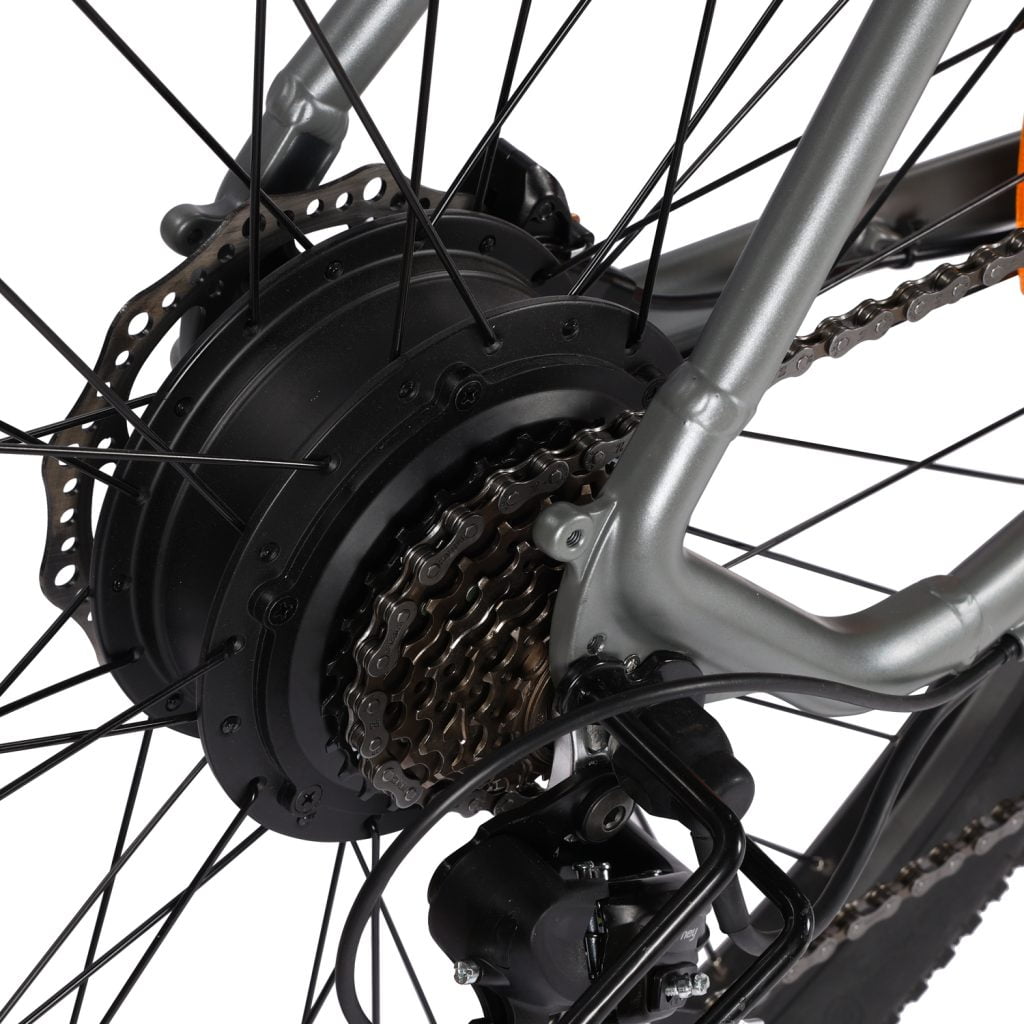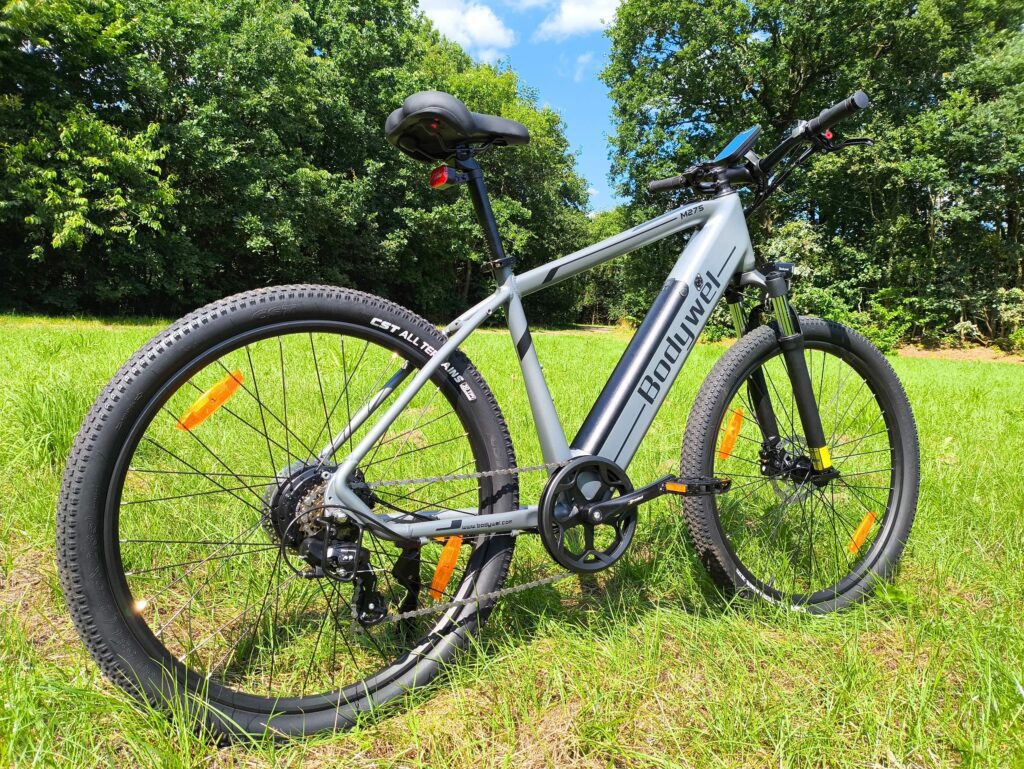Mountain biking provides a sense of adventure ,excitement and the exhilaration of conquering various terrains. Understanding the functioning of mountain bike gears is crucial for riding with confidence. For individuals curious about the mechanics behind mountain bike gears ,it lies in the design that enables riders to adapt their pedaling to the terrain.
Operating mountain bike equipment involves more than shifting gears. It’s about optimizing the bike for the best performance. Whether you’re tackling inclines or cruising on level terrain ,gears ensure smooth transitions. This manual aims to educate cyclists on the mechanics of mountain bike gears ,enhancing their rides for both efficiency and enjoyment.
Make sure you familiarize yourself with how the gears on your bike work ,before you go for your mountain biking adventure. It’s important to understand everything ,from how the shift mechanisms function ,to selecting the gear ratios to fully appreciate your biking journey. Dive into the details of mountain bike gearing to enrich your time on the trails.
Introduction to Mountain Bike Gearing
Starting a mountain trail ride needs skill, endurance, and knowing your bike’s gears. Mountain bike gears explained here will help new and experienced riders understand how gears make riding better. Knowing about the mountain bike gear system lets you ride better and enjoy more.
When you’re out for mountain biking ,it’s crucial to adapt the gears according to the terrain. Gears play a role in managing your speed and strength ,making it simpler to navigate different types of trails. Mastering the art of gear shifting is essential ,as it can enhance your speed ,stamina and ensure your bike lasts long.
-
- Understanding how gears impact speed and control
-
- Mastering the timing and execution of gear shifts
-
- Choosing the right gear for terrain and riding conditions
Let us take a look at the parts of gear ,and discover how they work in the upcoming sections. Keep reading to improve your mountain biking adventures, with tips and firsthand knowledge.
Mountain Bike Gear System Overview
Exploring the gear system of a mountain bike can enhance your riding experience. Various crucial components collaborate to facilitate smooth gear shifting enabling you to navigate trails with ease.
Components of the Drivetrain
The components of a mountain bike drivetrain play a role in its functionality. These parts consist of the chain responsible for transferring power from the pedals to the wheel ,the derailleur that facilitates gear shifting and the crankset that links up with the pedals. It is essential for all these elements to function effectively ,for the bike to operate smoothly.
Understanding the Gear Cassette on a Mountain Bike
The gear cassette plays a vital role in the gear system of a mountain bike. Positioned on the wheel hub ,it consists of different sized sprockets. This setup allows the bike to access a selection of gears ,making it ideal for navigating inclines or speeding down descents.
The size of the cassette and the number of sprockets on a bike impact its gear ratio ,influencing how easy or difficult it is to pedal and altering the speed at which you ride.
Functionality of the Mountain Bike Gear Selector
The gear shifter plays a role in understanding the mountain bike’s gear system. It allows cyclists to choose the chains position ,impacting the bikes speed and pedal resistance depending on the terrain.
Becoming proficient in operating the gear shifter can improve your riding enjoyment during long trips ,making them easier to handle ,and less tiring.
| Component | Function | Impact on Riding Experience |
| Chain | Transmits pedal power to drive the bike forward. | Smooth, responsive movement. |
| Derailleur | Shifts the chain between gears on the cassette. | Enables versatility in handling diverse terrains. |
| Crankset | Conveys pedal force directly affecting speed and efficiency. | Directly affects speed control and acceleration. |
| Gear Cassette | Houses varying sized sprockets for different gears. | Facilitates easy transition across various inclines and terrains. |
| Gear Selector | Allows rider to choose and change gears. | Empowers riders with speed adjustment and better energy management. |

How do the gears work on a mountain bike
Mountain biking heavily depends on using gear shifts to enhance performance on varying terrains. Gears allow cyclists to modify their pedaling intensity and speed crucial for conquering inclines and rugged trails. The credit goes to cutting edge technology in mountain bike gear and clever gear ratios.
The bicycle chain, crankset, and rear cassette are central to this system. Understanding bicycle gear ratios is crucial for picking the right gear for the situation. Changing gears changes the ratio of teeth on the front and rear gears. A higher ratio means harder pedaling but more distance covered with each turn. A lower ratio makes pedaling easier but slows you down, perfect for going uphill.
-
- The front gears are changed with the left-hand shifter, which controls the chainring on the crank.
-
- The rear gears are managed by the right-hand shifter, which operates the cassette on the rear wheel.
-
- Using the shifter moves the derailleur to shift the chain to another gear, changing the resistance.
In today’s world of mountain biking ,advancements in gear technology have introduced innovations ,such as synchro shift. This feature simplifies the gear shifting process by coordinating the rear derailleurs using just one shifter. As a result ,cyclists can now concentrate more on navigating the trail than worrying about adjusting gears.
The combination of components enables seamless gear changes. It allows cyclists to adjust effortlessly to different terrains. This guarantees they maintain control ,stability and effectiveness ,enhancing their enjoyment and performance while mountain biking.
Understanding Mountain Bike Gear Ratios
Knowing the gear ratios on your mountain bike is essential to improve your riding enjoyment ,and guarantee comfort while hitting the trails. The setup of gears influences how easily you can handle types of terrain. This part explores the significance of gear ratios ,in the world of mountain biking.
The gear ratio is about comparing the number of teeth on the front chainring ,with those on the cassette connected to the rear wheel. This setup dictates how hard or easy it is to pedal. Knowing these ratios helps cyclists pick the gear for various riding situations.
-
- Low Gear Ratios: These are for climbing steep hills. They make pedaling easier, making uphill less hard.
-
- High Gear Ratios: For flat or downhill paths, these need more pedal power but let you go faster.
Determining the optimal gear ratios for a mountain bike relies on several factors ,such as the riders abilities ,the bikes specifications ,and the terrain conditions. Below are a few configurations to consider:
| Gear Setup | Use Case | Advantage |
| 1×11 | Trail Riding | Simplicity and weight reduction |
| 2×10 | Versatile Riding | Balance of speed and torque |
| 3×9 | Technical Climbs | Wide range of gears |
Tuning gear ratios in the realm of mountain biking involves more than switching gears. It encompasses grasping the workings of your bikes gear system , in order to unleash its capabilities. Mastering this skill can enhance the efficiency and enjoyment of mountain biking endeavors.
Mountain Bike Gear Shifting Explained
Any passionate mountain biker knows how crucial perfect gear shifts are for a ride. This part explores the details of bike gear shifting ,provides tips on switching gears on various terrains ,and demonstrates how to make the most of gears in riding situations.
The Bike Gear Shifting Process
When you switch gears on a bicycle it requires both making adjustments and moving your body. By mastering this skill ,cyclists can pedal smoothly on different types of terrain. Knowing the timing and approach to changing gears can improve the biking experience ,making it more pleasurable and less strenuous.
Mastering Mountain Bike Gear Changes
To master the art of changing gears while cycling on a mountain bike ,riders need to hone their timing and adjust their pedal pressure accordingly. Making gear shifts at the right moment and with the appropriate amount of force can reduce strain on the bike ,keep the forward motion steady. Improving these skills comes with practice on various trails.
Optimizing Gear Usage in Mountain Biking
Selecting the right gears for the terrain and weather conditions plays a crucial role in mountain biking. Optimal gear choice not only conserves energy ,but also ensures smooth bike performance. Below are some pointers on using gears :
-
- Shift to lower gears for steep climbs to keep pedaling smoothly and save energy.
-
- Use higher gears for descents to speed up while staying in control.
-
- Change gears before terrain changes to avoid sudden shifts that can harm the bike.
During your bike rides ,incorporating these suggestions can improve your gear shifting skills ,leading to smooth transitions. This will optimize the use of your gears ,and enhance the enjoyment and efficiency of your rides.

Benefits of Using Gears on a Mountain Bike
Mountain biking demands flexibility and adaptability ,from both the rider and the bike. The gear systems efficiency significantly influences the mountain biking journey. Let us delve into why having the right gears is crucial for mountain biking enthusiasts.
Enhanced Control Over Different Terrains
Mountain biking enthusiasts delight in the excitement of discovering landscapes. The benefits of using gears on a mountain bike are clear ,when tackling climbs or cruising down hills. Gears enable riders to adjust their pace and power based on the terrain ,ensuring an controlled journey from start to finish.
Efficiency in Power Transfer
Selecting the gears enhances the efficiency of mountain biking. Choosing gears for different terrains enables cyclists to optimize their energy usage ,resulting in quicker ascents and more seamless descents ,while preventing excessive fatigue. This aspect is crucial for longer journeys and challenging paths.
Importance of Gearing in Mountain Biking
Gearing plays a role in mountain biking, impacting performance, enjoyment and safety. A well equipped bike translates the riders energy into movement effectively ,allowing for easier navigation of diverse terrains and longer more enjoyable rides with less fatigue.
| Terrain Type | Recommended Gear | Benefits |
| Steep Inclines | Low Gear | Increases torque, reduces strain on legs |
| Flat Trails | Medium Gear | Balances speed and resistance for steady cycling |
| Rapid Descents | High Gear | Allows faster speeds with less pedaling effort |
Understanding the mechanics of gears can enhance the enjoyment and ease of a bike ride. Gears play a key role in mastering the art of mountain biking ,going beyond bike components.

How to Change Gears on a Mountain Bike
Becoming skilled at changing gears while riding a mountain bike can greatly improve your biking adventures ,adding fun and thrill to the experience. This guide gives a glimpse into the basics of tweaking gears on a mountain bike. It also shares tips, for cyclists looking to enhance their gear shifting abilities.
-
- Anticipate the Terrain: Shift gears before the terrain changes. It’s best to adjust gears while pedaling lightly.
-
- Keep Pedaling: Continue pedaling at a moderate pace when shifting. This motion aids the chain in catching the new gear smoothly.
-
- Avoid Cross-Chaining: Use gears that position the chain as straight as possible to reduce strain and wear.
Switching gears smoothly can conserve energy ,and maintain your bikes performance. Let’s delve into the methods for adjusting gears based on various terrains.
| Terrain Type | Optimal Gearing Strategy | Typical Gear Combinations |
| Flat Surfaces | Use middle gears for steady cadence. | Chainring: Middle; Rear: Middle range |
| Uphill Climbs | Shift to lower gears to ease pedaling. | Chainring: Smallest; Rear: Largest cogs |
| Downhill Descents | Switch to higher gears to maximize speed. | Chainring: Largest; Rear: Smallest cogs |
Mastering mountain bike gear shifting with these gear changing techniques for cyclists will make you a pro on any trail. Practice these moves, and soon, they’ll feel natural. You’ll conquer various terrains with ease.
Gear Selection for Different Terrains
Picking the right equipment for your mountain bike plays a key role in navigating outdoor trails. Changing gears seamlessly enhances your riding experience across terrains ,prolongs the lifespan of your bike ,and boosts your stamina during your journey. Mastering the art of adjusting gear according to landscapes can elevate your cycling performance ,particularly when tackling downhill obstacles.
Adjusting to Uphill and Downhill Challenges
When you encounter hills , switch to lower gears to make pedaling more manageable. This will help conserve your energy and improve traction on the road. Conversely , when going downhill ,opt for higher gears to regulate your speed and reduce the strain on your brakes. Properly adjusting your gears does not prevent fatigue for both you and your bike only , but also promotes stability and control throughout your ride.
Strategies for Optimal Gear Selection
-
- Assess the Terrain: Look at the trail before you start. Plan your gear use to avoid problems and ride better.
-
- Listen to Your Bike: Notice if pedaling feels hard or too easy. Switching gears when needed is key to good mountain biking.
-
- Practice Makes Perfect: Riding on various terrains helps you know when to change gears. With time, adjusting your gear will become second nature.
To elevate their mountain biking journey , riders can use these tips to choose the right gear. This guarantees an smooth adventure , whether tackling slopes or cruising on flat trails. Getting the hang of picking the gear is a talent that gets better with time.
Troubleshooting Bike Gear Problems
Mountain biking offers an demanding experience ,putting both the rider and the bike to the test. Challenges with gear frequently arise ,leading to difficulties in maintaining a ride. Understanding how to tune and care for your bikes gears is essential for a journey.
Identifying Common Gear Issues
Initially you should identify the issue. Common problems include gears slipping , producing noise , or failing to engage. These issues typically arise from parts being out of alignment components that have worn out or insufficient lubrication.
How to Adjust Mountain Bike Gears
Fine tuning the gears on your bicycle may seem daunting. However , it is actually simpler than you imagine. Start by ensuring that your derailleur is properly adjusted for your bike. Next , adjust the cable tension to address any shifting issues. Remember to inspect the limit screws to guarantee movement of the chain.
Tips for Maintaining Your Bike’s Gear System
To ensure your bike stays in condition and lasts longer , it’s important to maintain it regularly. After riding in messy conditions and clean your drivetrain. Keep it well lubricated for smoother gear shifts. Additionally , replace any worn out parts promptly to maintain the reliability of your gear system.
| Issue | Cause | Solution |
| Gears slipping | Worn out chain or gears | Replace chain or gears |
| Noisy drivetrain | Lack of lubrication | Apply quality bike lubricant |
| Hard shifting | Cable tension | Adjust cable tension |
| Chain dropping | Improper limit screw adjustment | Adjust limit screws |
Understanding Mountain Bike Gear Technology
The advancements in mountain bike equipment technology have revolutionized our riding experiences , offering cyclists control and efficiency. The pivotal components driving these transformations are the mountain bike gear system and drivetrain. Understanding the intricacies of mountain bike shifting empowers cyclists to enhance their performance and navigate various terrains with ease.
Recently , there have been some developments in mountain bike drivetrains. Thanks to improved materials and creative designs , the parts have gotten lighter and sturdier. Now they can handle tough conditions , and provide consistent performance.
| Component | Material Used | Benefit | |
| Cassette | High-Tensile Steel | Durability and longevity under stress | |
| Chain | Chromium Alloy | Corrosion resistance, smoother shifting | |
| Derailleur | Carbon Fiber | Lightweight, minimal impact on bike weight | |
Advancements in technology have also enhanced the functionality of mountain bike gear systems , making them more automated and user friendly. With shifters ,cyclists can effortlessly and swiftly adjust gears ,thereby enhancing their biking experience and performance on mountain trails.
-
- Improved responsive time in gear shifting
-
- Decreased physical exertion for gear changes
-
- Enhanced precision in challenging terrains

Analyzing the Bodywel M275’s Gear System
The Bodywel M275 distinguishes itself in the realm of mountain bike ,with its setup that improves performance and comfort. Let us now take a look at examining the characteristics of this model.
Key Features of Bodywel M275’s Drivetrain
The Bodywel M275 features a high quality drivetrain, for both cyclists and beginners alike. Each component is designed to deliver accurate performance across biking terrains. Crafted from materials ,this bike ensures lasting quality and exceptional performance.
Benefits of the Gear Setup in Bodywel M275
The gear arrangement in the Bodywel M275 significantly enhances the biking adventure. Cyclists enjoy gear transitions ,because of the incorporated gear mechanism. This proves essential for conquering landscapes that require gear adjustments. Moreover ,the gear levers are ergonomically crafted for convenience and effortless operation.
| Feature | Description | Impact on Ride |
| High-quality chain rings | Made from durable alloy materials | Enhances longevity and reliability of the drivetrain |
| Optimized gear ratios | Wide range of gear settings | Facilitates ease of climbing and speed on flats |
| Ergonomic gear shifters | Smooth and natural grip | Reduces fatigue, increases control in shifting |
In essence ,the gear mechanism of the Bodywel M275 significantly enhances the mountain biking experience. Exploring these characteristics showcases the prowess of the Bodywel M275 ,and underscores the significance of a reliable gear system in cycling.
Conclusion
Delving into the mechanisms of mountain bike gears unveils a realm of precise engineering. This precision aids cyclists in navigating various terrains with smooth transitions. Understanding the functionality of your bikes gears is essential for enhancing your riding experience.
Recognizing the significance of switching gears is crucial for maneuvering through landscapes and bumpy trails. Enhancing this ability can enhance your cycling experience ,making it both more pleasurable and less exhausting. The suggestions provided in this article aim to assist you in honing your gear shifting proficiency ,ultimately enhancing the enjoyment of your rides.
Mastering gear systems in cycling requires dedication and hands on learning. Our recommendation is to apply the knowledge acquired from this article to optimize your bikes gear setup. Continuously honing your skills and putting them into action will lead to maneuverability ,speed and enjoyment during mountain biking adventures.
FAQ
How do the gears work on a mountain bike?
Mountain bike gears work with the chain, cassette, derailleurs, and shifters. When shifting gears, the shifter moves the chain to different cogs on the cassette and chainrings. This changes the gear ratio, making pedaling easier or harder for different terrains.
What is the importance of understanding mountain bike gearing?
Knowing how mountain bike gearing works helps riders pick the best gear for the terrain. This saves energy, increases speed, and improves control. It also makes gear transitions smoother and enhances the biking experience.
How can one optimize gear usage in mountain biking?
To optimize gear usage, anticipate terrain changes and shift gears accordingly. Keep a steady cadence, use a gear that lets you pedal efficiently without strain, and shift smoothly to avoid drivetrain stress.
What are the benefits of using gears on a mountain bike?
Gears on a mountain bike improve control on tough terrains, enhance power transfer, and help maintain speed across different conditions. Proper gear use also reduces fatigue by making pedaling easier when needed.
How should one change gears on a mountain bike?
Change gears using the shifters on the handlebars. Pedal lightly for smoother shifts and anticipate gear changes. Avoid cross-chaining to prevent drivetrain wear.
What should I know about troubleshooting bike gear problems?
Common issues include skipping, noise, or difficulty shifting gears. Clean and lubricate the drivetrain, adjust cables, and align derailleurs regularly. For ongoing problems, seek professional help.
How does the mountain bike gear selector function?
The gear selector on a mountain bike shifts gears by moving the chain to different cogs or chainrings. It uses electronic signals or mechanical cables connected to the derailleurs.
Why is it crucial to master mountain bike gear changes?
Mastering gear changes is key for smooth, efficient riding. It maintains momentum, saves energy, and prevents mechanical issues. It boosts confidence in tackling various terrains.


